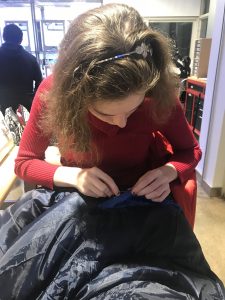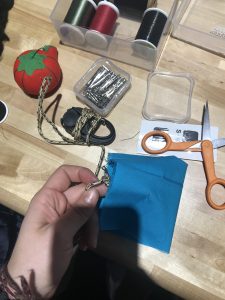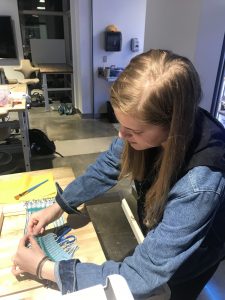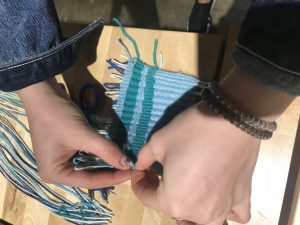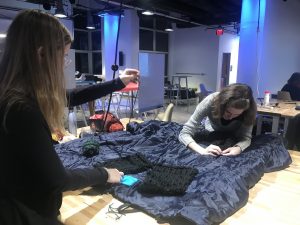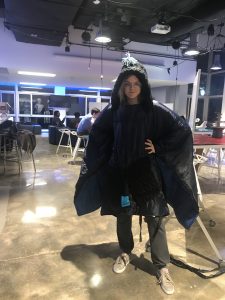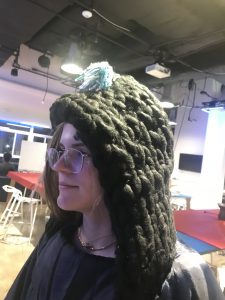THE SACK OF ALL TRADES
We (a reputable global news network) caught up with the innovators of the new Sack of All Trades, a jacket, sleeping bag/ hammock combo that has recently taken the world by storm and captivated the hearts of so many. These so-called “Weavers of our Generation” had a lot to say.
Jessica: This project began when Sam found an ordinary sleeping bag at the Scrap Exchange in Durham. She also had the inspiration for the project itself while Chandler and I provided the teamwork to get it done on time. I had an additional background in sewing; Sam had embroidery/weaving experience, and that was how we began.
Sam: I was inspired to create a coat or poncho that turns into a warm hammock for sleeping purposes as I watched my roomate struggle to pack various different layers and equipment for her weekend camping trip. I saw her eno hammock and thought that it would be super easy to make a hammock that turns into a pocho. As I did some more pondering and searching on the web, I found lightweight jackets for refugees that turn into tents. I thought this was an awesome idea, but it would be even better if we could make a prototype that could provide warmth and a place to sleep, designed especially as a band-aid solution to help the homeless during cold winter months. If stores like REI could design this type of multi-use equipment for camping, why couldn’t the concept be adapted for less economically advantaged populations?
Chandler: This product was Sam’s brainchild, but due to the mixture of many heavy materials, Jessica and I were also brainstorming how to logistically make the piece function as consciously and efficiently as possible since it was made for someone who was on the go. This included deciding on whether to hand stitch or use the sewing machine on different materials, deciding the best materials and needle types for stitching, and strategically placing snaps so that the piece would be both easy and fast to use. I also tried to make the work somewhat aesthetically pleasing by having a color scheme of grays, blues, and greens, adding understated decorative elements so the piece would still be fun to show off and wear.
Jessica: Due to the size of the sleeping bag, the most convenient place for us to meet was the Carmichael MakerSpace which, unlike other MakerSpaces, stays open until 10pm. It was a pleasant surprise on our first day of work. Sam showed up with the sticky notes and other diagrams for how to turn a sleeping bag into a poncho/hammock all ready.
Sam: I drew up several diagrams in advance to make sure logistically all the pieces would fit together; for instance, the snaps had to be on the correct side opposing one another. I also used thick black yarn and wove it on a small ‘zippy’ loom to create the pockets and hood.
Jessica: We began by folding the sleeping bag in half to get an accurate measurement of where to put the neck hole, drew the line in chalk, and cut through both layers of synthetic (probably nylon) fabric. I then slip-stitched the neck hole closed for a more finished appearance where you ideally didn’t see the threads.
Chandler: Sam and I took two pieces of blue fabric and made pockets on the sewing machine by folding each piece in half and sewing along three sides with fabric found in the MakerSpace. We then flipped the fabric so the stitches were not visible.
Sam: We punctured holes in the back of the pockets, inserted the end of the carabiner rope, and tied a tight knot so that the carabiner on its rope would sit comfortably in the pocket when not in use. We attached velcro inside the pockets so that they could close shut. Lastly, we measured where to place the pockets and sewed them at the end of the poncho lengthwise so that, ideally, they could hold an individual while they were strapped into a tree. (Note: This is just a prototype; we do not believe this could hold the weight of a human adult.)
Chandler: I took the loom that we had built in class and wove a blue patch prior to meeting. I created a stripe pattern utilizing three different types of weaves for aesthetic purposes: the twill, the plain, and the basket weaves to have a decorative spot where the hood could be attached to the back of the jacket/ sleeping bag/ hammock so to not be in the way. I sewed two snaps onto this patch; one to attach the hood and one to attach the pom-pom I created to go on top of the hood when it was not in use, so the user would not have to worry about it getting lost. I wanted to add these decorative elements so that this item wasn’t so strictly utilitarian but also in a way that wouldn’t drive up its price. It was a way to add a more aesthetic element to the piece so that it could still be a fun garment that a more fashion-conscious person would be proud to wear and show off.
Jessica: At some point after finishing the neck hole, I stitched in the wrist snaps so that the garment when draped over the arms acted more like sleeves (part of Sam’s design). All that was left was putting everything together. After realizing that regular, cotton/polyester thread was too weak to keep the thick yarn attached, we returned two days later when we could meet again with Sam’s embroidery needle. Fortunately, MakerSpace had extra embroidery needles, so we could all work on attaching the pockets, patches, and hood at the same time. When it was finished, we tested the wearability and hanging functions. We made sure not to cut off the sleeping bag straps so that this new garment could roll up again for easy transport.
Chandler: I decided to call this the “Sack of All Trades” because it was a sack-like object when not in use but could transition from a “person sack” (a jacket) to a “ground sack” (a sleeping bag) to an “air sack” (a hammock). The versatility of its basic sack-like shape is counterintuitive, and I thought that this was both cool and humorous.
Sam: All and all, we utilized new skills and a variety of materials and textures. We are now able to better understand the physical principles and differences between light nylon and heavy wool. Additionally, I was pleased by how well it all came together. When I first tried on the poncho without the pockets, it was so heavy due to the hood, that I was nearly choked by the garment. Once we added the pockets, the weight was much more evenly distributed, and I could breathe. This was essential to the garment’s wearability and not something I would have ever considered prior to this experience.
Jessica: We used both weaving and sewing, hand stitching as well as machine stitching. Honestly, that synthetic fabric bothered me a lot because once you poked a hole in it with any needle, that hole wasn’t coming out again.
Chandler: For this project, we tried to view textiles through multiple lenses; that of a consumer but also of a human with basic needs. For this reason, our garment acted not only as a potential commodity for retailers targeting those interested in living light while hiking or traveling, but it would hopefully act as a home for someone who is truly in need, like a refugee or someone facing homelessness in their own country. However, we discussed the paradox of these two uses because, if made to be durable and light, the average avid outdoorsman would have no qualms paying upwards of $400 for a “three in one” piece like this, as jackets from high end brands can easily be $200-300, while hammocks run around $100, and tents can be $300-400 on their own. This could be a highly marketable product with niche buyers. However, being made well to be durable and light would also make it a product that would improve the lives of so many people struggling financially or even fleeing for their lives due to government unrest. To reach these audiences, this could not be a luxury sporting good but a product that would have to be sold at close to its cost of production. How could this product exist as both a utilitarian home and a luxury sporting good? The materials would cost the same for either branding, but its novelty in the outdoor goods market would likely drive up the price.
This caused us to consider textiles in an new way, leading to the question of how much better could the lives of those facing harsh conditions, even if not by choice, be bettered by those textiles which are novelty luxury goods (like down jackets, sub-zero sleeping bags, and ultra-light tents), typically used by middle to upper class “weekend warriors” with jobs, a home, and sustenance?
